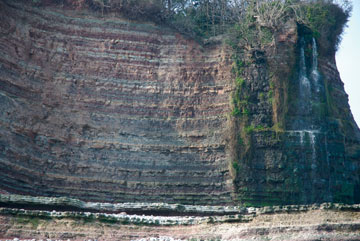|
NEWS NOTES
Putting time constraints on the Triassic
 Angela Coe |
| The red and green stripes on the rocks at St. Audrie’s Bay in southwestern England record past climatic changes, allowing scientists to date these Triassic-aged rocks. |
The breakup of a supercontinent, rampant volcanism, meteor impacts and a couple of global extinctions sound like the backdrop to a big-budget disaster movie. Yet this is no movie, but actual events in the Triassic period — some 250 million to 200 million years ago. Although scientists have a rough idea of the timing of the period’s major events, the geologic time scale of the Triassic is quite patchy and unrefined compared to the precise time records of more recent periods in the Cenozoic Era, making it difficult for scientists to infer processes and rates of change in past biological and climatic systems. But two geologists recently learned that an ordinary color scanner and knowledge of Earth’s orbital cycles can help remedy the situation.
Dating layers of rock isn’t easy, says Dave Kemp of Neftex Petroleum Consultants Ltd. in the United Kingdom. The job is a bit easier when the layers contain characteristic fossils unique to different time periods or if a layer contains volcanic ash that can be radiometrically dated. Still, these dating methods, at best, are only precise to within several hundred thousand years. And things get even trickier when researchers try to correlate different layers from around the world to piece together a global time scale.
In the absence of the usual dating options, Kemp and his colleague Angela Coe of The Open University in the United Kingdom wanted to see if they could use astronomical cycles — such as periodic changes in the shape of Earth’s orbit around the sun, or its eccentricity, that cause regular changes in climate — to not only provide time constraints for a succession of rocks from St. Audrie’s Bay in southwestern England but also to give researchers a method to precisely correlate rocks across continents.
The rock cliffs along the coast at St. Audrie’s Bay display horizontal red and green stripes. These colors correspond with different iron oxidation states of sediments laid down in a large lake, which are a function of different climatic conditions, Kemp says. Kemp and Coe used changes in the rock’s color to infer climatic cycles. After creating digital images of scanned rock samples and comparing them to standard color chips to precisely note color changes, the pair detected definite, regular patterns. Such climatic cycles are directly tied to regular changes in Earth’s orbital patterns. For example, changes in Earth’s eccentricity occur regularly at 100,000-year and 400,000-year intervals, but changes in its axial tilt occur every 38,000 years. But without any age constraints on the St. Audrie’s Bay succession, the team could not determine which orbital cycles these patterns represented. To do that, they had to rely on reversals in Earth’s magnetic poles and another rock succession across the Atlantic.
Previously, other researchers had mapped out the periods of magnetic pole reversals in the St. Audrie’s Bay succession. Earth’s magnetic poles flip periodically at irregular intervals, and these flips are recorded in rock as changes in the direction iron grains line up. Kemp and Coe created multiple age estimates for the different periods of polarity in the rocks assuming the cyclic color pattern represented different astronomical cycles. Next, they used a statistical model to correlate their different age estimates with the known, dated polarity periods of the Newark Basin time scale from the northeastern United States — the “standard geological time scale for the Late Triassic,” Coe says. The estimates using the 100,000-year eccentricity cycles matched up best with the Newark Basin, the pair reported in November’s Geology.
The correlation with the Newark Basin allowed Kemp and Coe to verify that their rock succession was of Norian age near the end of the Triassic, something previous researchers had already inferred, says Jim Briden of the Oxford University Centre for the Environment in the United Kingdom. And by adding up all of the 100,000-year cycles, Kemp and Coe determined their succession represents 3.7 million years of time.
“[They’ve] got a pretty compelling case,” says Paul Olsen of Columbia University in New York, who helped create the Newark Basin time scale. “The correlation with the Newark Basin time scale is very convincing.”
The work also confirms that correlating rocks with astronomical cycles is much more accurate than most other dating techniques, Kemp says. While correlating fossils and radiometric dating yield error margins of a few hundred thousand years to well over a million years, astronomical cycles are precise to within a hundred thousand years or less. “That’s pretty accurate,” Kemp says. “That’s about as good as you get.”
Giving the Triassic more accurate time constraints will allow researchers to better understand important events of that period, Coe says. For example, understanding rates of biological change in the fossil record — something that’s hard to do without a precise time scale — will help researchers better understand the mass extinction at the end of the Triassic. The next step is to further work out the time scale in other parts of the St. Audrie’s Bay succession, Coe says.

 Subscribe
Subscribe


